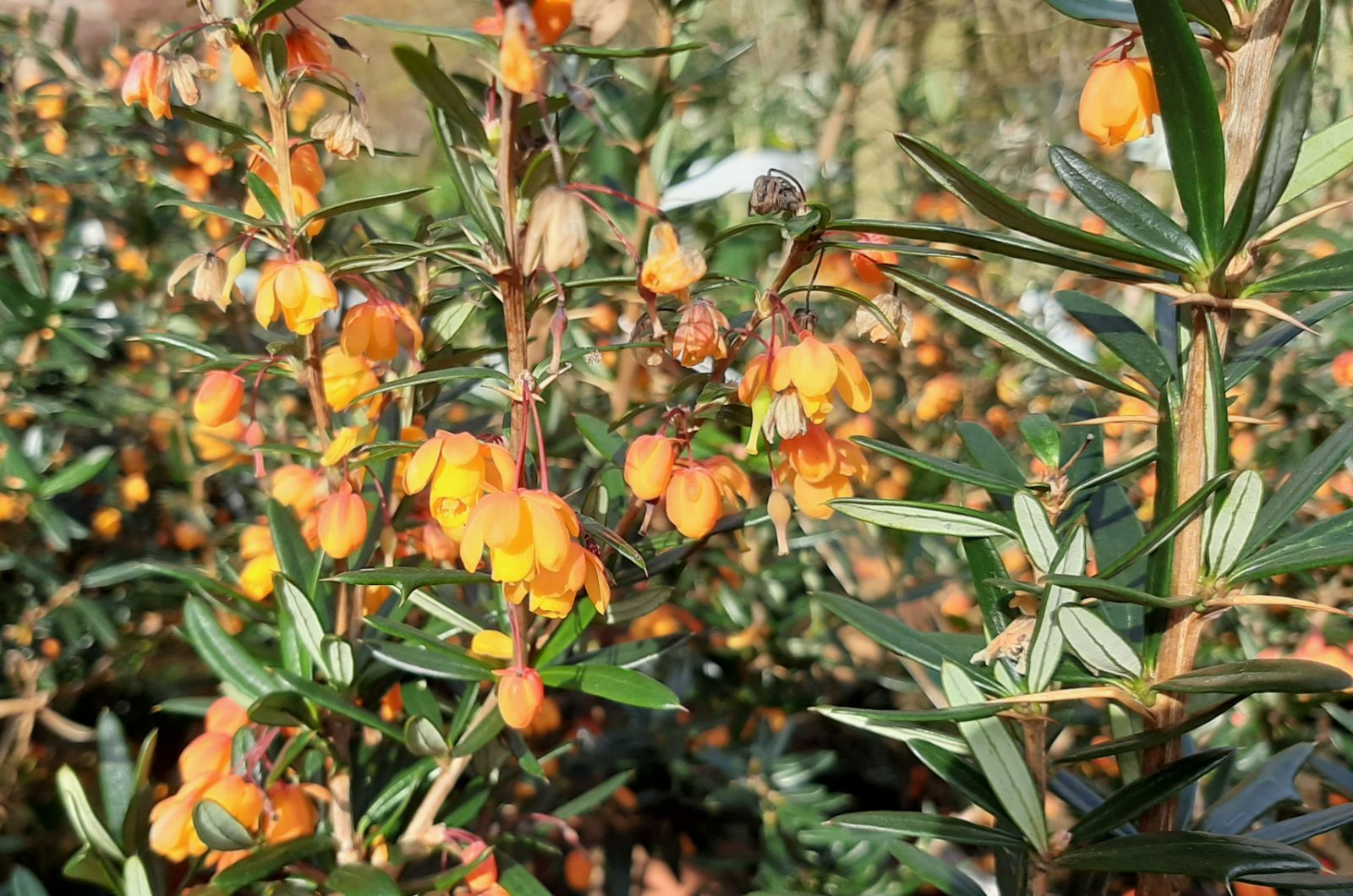Berberis linearifolia
Credits
Article from Bean's Trees and Shrubs Hardy in the British Isles
Recommended citation
'Berberis linearifolia' from the website Trees and Shrubs Online (treesandshrubsonline.
Genus
Infraspecifics
Other taxa in genus
- Berberis actinacantha
- Berberis aetnensis
- Berberis aggregata
- Berberis angulosa
- Berberis aristata
- Berberis asiatica
- Berberis atrocarpa
- Berberis beaniana
- Berberis bergmanniae
- Berberis buxifolia
- Berberis calliantha
- Berberis canadensis
- Berberis candidula
- Berberis × carminea
- Berberis chillanensis
- Berberis chrysosphaera
- Berberis comberi
- Berberis concinna
- Berberis coxii
- Berberis cretica
- Berberis darwinii
- Berberis dasystachya
- Berberis diaphana
- Berberis dictyoneura
- Berberis dictyophylla
- Berberis empetrifolia
- Berberis fendleri
- Berberis francisci-ferdinandii
- Berberis gagnepainii
- Berberis glaucocarpa
- Berberis gyalaica
- Berberis hakeoides
- Berberis heterophylla
- Berberis heteropoda
- Berberis hispanica
- Berberis hookeri
- Berberis hypokerina
- Berberis ilicifolia
- Berberis incrassata
- Berberis insignis
- Berberis jamesiana
- Berberis johannis
- Berberis julianae
- Berberis kawakamii
- Berberis koreana
- Berberis lecomtei
- Berberis lepidifolia
- Berberis lycioides
- Berberis lycium
- Berberis manipurana
- Berberis mitifolia
- Berberis montana
- Berberis morrisonensis
- Berberis mucrifolia
- Berberis orthobotrys
- Berberis poiretii
- Berberis prattii
- Berberis pruinosa
- Berberis replicata
- Berberis × rubrostilla
- Berberis sanguinea
- Berberis sargentiana
- Berberis sibirica
- Berberis sieboldii
- Berberis silva-taroucana
- Berberis soulieana
- Berberis × stenophylla
- Berberis sublevis
- Berberis temolaica
- Berberis thunbergii
- Berberis tischleri
- Berberis triacanthophora
- Berberis tsarongensis
- Berberis umbellata
- Berberis valdiviana
- Berberis veitchii
- Berberis vernae
- Berberis verruculosa
- Berberis virescens
- Berberis vulgaris
- Berberis wardii
- Berberis wilsoniae
- Berberis yunnanensis
- Berberis zabeliana
An evergreen shrub of loose, erect habit, 4 to 8 ft high; young shoots ribbed, not downy, armed with three-forked spines 1⁄4 to 5⁄8 in. long. Leaves arranged in clusters of three to six at each joint, linear, spine-tipped, tapered towards both ends, toothless; 3⁄4 to 13⁄4 in. long, 1⁄4 in. or less wide; dark shining green above, glaucous beneath, of leathery texture, scarcely stalked; margins recurved. Flowers clustered at the joints, four to six together, each on its own very slender red stalk 1⁄2 to 11⁄4 in. long; they are of a rich orange colour internally and of a beautiful apricot colour outside, and measure about 5⁄8 to 3⁄4 in. across when open. Fruit black, covered with a blue bloom, egg-shaped, 1⁄2 in. long, terminated by the conspicuous style. Bot. Mag., t. 9526.
Native of Chile; described by Philippi in 1856; introduced in 1927 by H. F. Comber, who found it at 3,400 ft altitude in shady moist woodland. Comber notes that it is ‘one of the best’, and, judging by small plants that flowered in less than three years from sowing the seed, that is a true estimate of its quality. The flowers are larger than those of B. darwinii and more richly coloured. It is of course very distinct from that barberry in its long, narrow, entire leaves. It appears to be very hardy, as two-year-old plants withstood the cold winter of 1928–9 out-of-doors at Kew without suffering in the least and flowered freely in April 1930. Clarence Elliott, who has seen it wild during his visits to Chile, speaks highly of its beauty. It seems remarkable that so excellent a shrub should have been overlooked so long, but I cannot find that it has been in cultivation before. A fine form was shown at the Horticultural Hall on 21st April 1931, by Lt-Col. Messel from his garden at Nymans and was given a First Class Certificate. It showed this species, both in the size and rich colour of its blooms, to be probably the finest of all the evergreen true barberries.
To the above account, first published in 1933, it is only necessary to add that in most gardens B. linearifolia came through the hard winters of the early sixties with little damage, and seems hardy enough in a position sheltered from cold, drying winds. It is tolerant of chalky soils.
From the Supplement (Vol. V)
Some clones of B. linearifolia have been named and are propagated by grafting. The best known of these are ‘Orange King’, with extra large, deeply coloured flowers; and ‘Jewel’, with flower-buds of a brilliant red and somewhat smaller leaves than normal. The latter was raised by Messrs Marchant from seeds collected in Chile by Clarence Elliott; the former is of Dutch origin.
A group of B. linearifolia at Borde Hill, Sussex, is from seeds collected in Chile in 1963. Although the fruits all came from a single bush, there is considerable variation in the colour of the buds and open flowers.
B. × lologensis – Another selection of this hybrid is ‘Stapehill’ (‘Stapehillensis’), which was found in a bed of B. darwinii seedlings in the nursery of Messrs Barthelemy and Son, Stapehill, Dorset, in the mid-1950s. The influence of B. linearifolia is shown in its early flowering (late March or early April), in the bright red flower buds and in the shape of the leaves.

